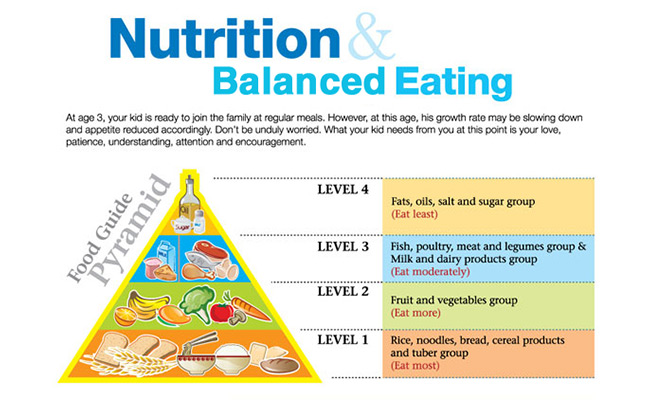
Guide for feeding toddler and pre-schooler
At this age, kids will be developing their food preferences. Take time to help cultivate lifelong good eating habits and healthy choices in your kid. Here's a guide to help you:
Offer your kid a healthy balanced diet according to the Food Pyramid. Not all meals require foods from each group but there should be a balanced and appropriate combination of foods within a day.
• At this age, encourage your kid to drink milk daily and it is important to ensure he gets the appropriate and adequate nutrients from other food groups as well.
• Begin establishing a schedule of three main meals a day, with snacks in between.
• Add new foods gradually so as not to overwhelm your kid with too many new tastes to sample at one time.
• While cooking a family dish, put aside some portions of the dish for your kid before adding spices.
Nutritious food is important for your kid because it :
• Provides nutrients for growth and development.
• Provides energy for active physical and mental activities.
• Helps maintain resistance to infections.
• Provides sufficient nutrients to meet future demands of growth at puberty and adolescence.
Balanced eating in kids
Healthy eating simply means making sure kids eat a variety of foods to get nutrients (such as protein, carbohydrate, fat, vitamins, and minerals) they require for normal growth. If kids eat a wide variety of food regularly, they will be well-nourished.
How much food is good for my kid?
Kids tend to eat the same number of calories every day if they are allowed to eat in response to their internal hunger gauge. The pattern of calorie intake is different from day to day. One day a child may eat a big breakfast, a big lunch, and hardly any dinner. The next day this same child may eat very little at breakfast but may eat a lot at lunch and dinner. Don't expect your child to eat the same amount of food at every meal and snack each day.
Division of responsibility to ensure your kids eat well & stay healthy
Like most parents, you might worry that your kids are eating too much, too little or only eating one type of food (eg. peanut butter sandwich). The way to ensure they eat well and you have less to worry about is to define the 'division of responsibility' – your responsibility as a parent, and your kids' responsibility as the subject of your care. The division of responsibility is summarised in the simplest way here:
• Your task - to offer nutritious food choices at meals and snack times. You decide the what, where, and when of eating.
• Your kids' task - to choose how much they will eat of the foods you serve. They decide how much or even whether to eat or not.
Division of responsibility may be a new idea that will take a little time for both you and your kids to get used to. However, once it's defined, kids will learn that they are allowed to eat as little or as much as they want, as long as they are choosing from the food options you provide at each meal and snack. In the process, they will also learn to trust their own hunger cues.